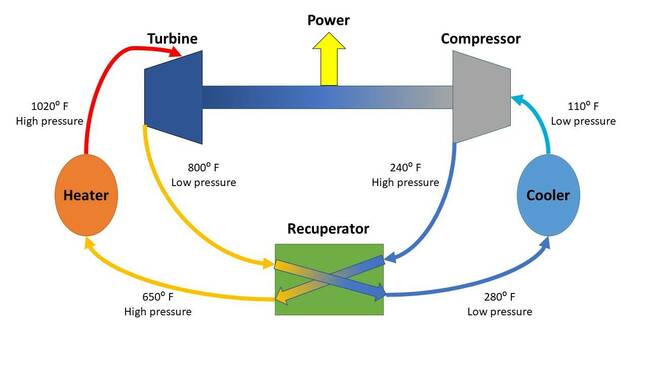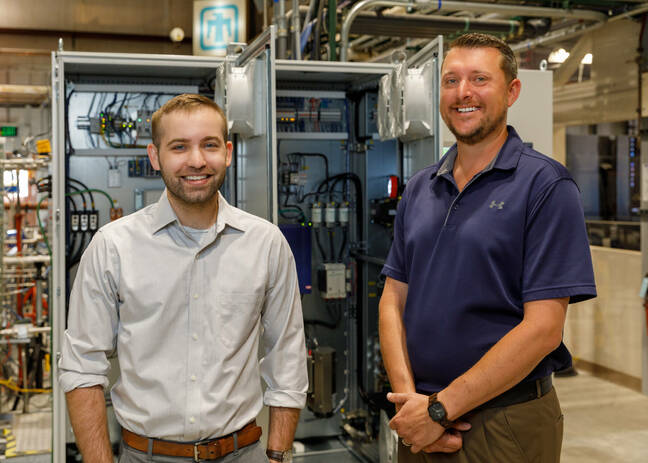This article is more than 1 year old
Scientists use supercritical carbon dioxide to power the grid
Sandia has been working on the project for more than a decade – now comes scaling
When it comes to turning turbines, steam is out and supercritical carbon dioxide is in – as demonstrated by Sandia National Labs when it connected a closed-loop system to the local grid, supplying about 10 kilowatts of power for nearly an hour.
Sandia's experimental unit uses carbon dioxide in a supercritical state (pressurized to behave like a liquid and gas) to move a turbine. Supercritical CO2 can get far hotter than steam, and could be far more efficient if scaled to power plant levels and heated via nuclear, solar or fossil fuels.
Ten kilowatt-hours isn't much, around one-third the energy used by the average US home in a day. However, the fact that the lab was able to connect its test loop directly to the grid is a huge deal, said lead researcher Darryn Fleming.
"It took us a long time to get the data needed to let us connect to the grid. Any person who controls an electrical grid is very cautious about what you sync to [it], because you could disrupt the grid," Fleming said.
In the (Brayton) loop
The Brayton cycle is a thermodynamic alternative to the Rankine cycle, which evaporates water to form steam used to turn turbines.
The Rankine cycle is inefficient and loses a lot of energy turning steam back into water, resulting in only around a third of the power generated being converted into electricity. Per Sandia, Brayton cycles can reach a theoretical conversion efficiency upwards of 50 percent.
In Sandia's system supercritical CO2 is heated, and energy is sent through a turbine. Upon exiting the turbine, the CO2 flows through a recuperator, which cools it before sending it to a compressor. The compressor re-pressurizes the cooled CO2, sends it back through the recuperator to recoup some heat, and then sends it back to the start. A portion of the system's efficiency, the US lab operator said, comes from the recouping process.
For the experiment, Sandia only heated its supercritical CO2 to 600°F (316°C), though fully realized systems would get much hotter. Sandia's diagrams of the system show high-pressure CO2 leaving the heater at nearly double the temperature.
Elevating the experiment to grid level
Prior to connecting its Closed Brayton-cycle test loop to the grid in April, Sandia had to find the right control system to regulate its output, and the team found it in an elevator component called a permanent magnet rotor.
The rotors are used to convert the potential energy of a moving elevator car into electricity, and they operate on a similar principle to the Brayton cycle test loop Sandia used in its experiment, the lab said.
"This similarity allowed the Sandia team to adapt commercial-off-the-shelf power electronics from an elevator parts company to control feeding power from their test loop into the grid," Sandia said in a statement.
Sandia mechanical engineer Logan Rapp said that coupling the lab's test loop with the elevator bits was a huge step forward, making the line between 10 kilowatts and a megawatt or more "pretty clear." One megawatt could power between 500 and 1,000 homes, and Sandia's industry partners are targeting 1 to 5 megawatts, Rapp said.
- Tesla expands Powerwall-to-grid program to cover most of California
- Cloud and datacenters start to feel the slowdown amid spiking energy costs
- Modeling software spins up plans for floating wind turbines
- More datacenters coming to Ireland, despite energy concerns
With a successful direct-to-grid test behind it, the Sandia team is now working to reach higher temperatures. In 2023 the team plans to build a two-turbine alternator generating system it said will be more efficient, and they aim to demonstrate a 1MW system by fall 2024.
To help make commercial development more appealing, Sandia spokesperson Mollie Rappe told us that Sandia engineers are working on validating parts of the system individually so interested companies can expand on the components as they see fit.
Sandia is no stranger to supercritical CO2 – it's been working on such systems for over a decade. At the time, Sandia said it was leading development, stopping short of describing the supercritical CO2 generators as all but inevitable. Eleven years later, we're starting to inch closer. ®


